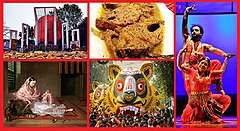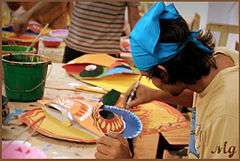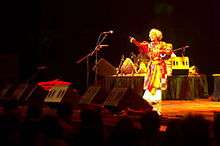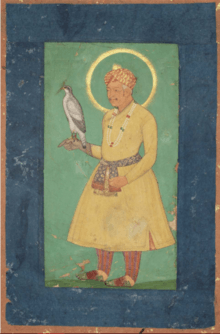Pahela Baishakh
Pahela Baishakh (Bengali: পহেলা বৈশাখ, romanized: Pohela Boishakh) or Bangla Noboborsho (Bengali: বাংলা নববর্ষ) is the first day of Bengali Calendar. It is celebrated on 14 April as a national holiday in Bangladesh, and on 14 or 15 April in the Indian states of West Bengal, Tripura and Northern Odisha and parts of Assam by people of Bengali heritage, irrespective of their religious faith.[2]
| Pahela Baishakh Bangla Noboborsho | |
|---|---|
 Pahela Baishakh celebration in Dhaka, Bangladesh | |
| Official name | Pahela Baishakh / পহেলা বৈশাখ |
| Also called | Bangla Noboborsho[1] |
| Observed by | Bengalis |
| Type | Social, cultural and national festival |
| Celebrations | Mangal Shobhajatra (processions), Boishakhi Mela (fair), gift-giving, visiting relatives and friends, songs, dance |
| Frequency | Annual |
| Related to | Vaisakhi, Vishu, Puthandu, Pana Sankranti, Sri Lankan New Year, Thai New Year, Cambodian New Year, Burmese New Year, Lao New Year, Ugadi |
| Part of a series on |
| Bengalis |
|---|
 |
|
Bengali homeland |
|
Bengali culture
|
|
Bengali symbols |
Celebration of Pahela Baishakh traces its roots during the Mughal rule in the region with the proclamation of tax collection reforms by Emperor Akbar. The festival date is set according to the lunisolar Bengali calendar as the first day of its first month Boishakh.[3] It therefore almost always falls on or about 14 April every year on the Gregorian calendar.[3] The same day is observed elsewhere as the traditional solar new year and a harvest festival, and is known by other names such as Vaisakhi in central and north India, Ugadi in South India Vishu in Kerala and Puthandu in Tamil Nadu.[4][5] The festival is celebrated with processions, fairs and family time. The traditional greeting for Bengali New Year is শুভ নববর্ষ "Shubho Noboborsho" which is literally "Happy New Year". The festive Mangal Shobhajatra is organized in Bangladesh. In 2016, the UNESCO declared this festivity organized by the Faculty of Fine Arts, University of Dhaka as a cultural heritage of humanity.[6]
Nomenclature
In Bengali, the word Pohela (Bengali: পহেলা) means 'first' and Boishakh (Bengali: বৈশাখ) is the first month of the Bengali calendar (Bengali: পহেলা বৈশাখ Pôhela Boishakh).[3] Bengali New Year is referred to in Bengali as Noboborsho (Bengali: নববর্ষ), where 'Nobo' means new and 'Borsho' means year.[5]
Origins
There are primarily two competing theories about the origin of Bengali New Year. Both theories are described below.
As per one of the theories, during the Mughal rule, land taxes were collected from Bengali people according to the Islamic Hijri calendar. This calendar was a lunar calendar, and its new year did not coincide with the solar agricultural cycles. According to some sources, the festival was a tradition introduced in Bengal during the rule of Mughal Emperor Akbar to time the tax year to the harvest, and the Bangla year was therewith called Bangabda. Akbar asked the royal astronomer Fathullah Shirazi to create a new calendar by combining the lunar Islamic calendar and solar Hindu calendar already in use, and this was known as Fosholi Shon (ফসলি সন; harvest calendar). According to some historians, this started the Bengali calendar.[7][8] According to the Bangladeshi academic and foklorist Shamsuzzaman Khan, it could be Nawab Murshid Quli Khan, a Mughal governor, who first used the tradition of Punyaho as "a day for ceremonial land tax collection", and used Akbar's fiscal policy to start the Bangla calendar.[9]
According to Shamsuzzaman Khan,[9] and Nitish Sengupta, the origin of the Bengali calendar is unclear.[10] According to Shamsuzzaman, it is called Bangla shon or shaal, which are Arabic (سن) and Persian (سال) words respectively, suggests that it was introduced by a Muslim king or sultan."[9] In contrast, according to Sengupta, its traditional name is Bangabda.[10][11] It is also unclear, whether it was adopted by Alauddin Husain Shah or Akbar. The tradition to use the Bengali calendar may have been started by Husain Shah before Akbar.[10] Regardless of who adopted the Bengali calendar and the new year, states Sengupta, it helped collect land taxes after the spring harvest based on traditional Bengali calendar, because the Islamic Hijri calendar created administrative difficulties in setting the collection date.[10]
There is another theory about the origin of the Bengali Calendar. Some historians attribute the Bengali calendar to the 7th-century king Shashanka.[9][10] The term Bangabda (Bangla year) is found too in two Shiva temples many centuries older than Akbar era. These temples are terracotta temples located in Bankura district of West Bengal, India. These inscriptions suggest that the Bengali calendar existed before Akbar's time.[10]
In rural Bengali Hindu communities of India, the Bengali calendar is credited to Vikramaditya, like many other parts of India and Nepal. However, unlike these regions where it starts in 57 BCE, the Bengali calendar starts from 593 CE suggesting that the starting reference year was adjusted at some point.[12][13]
Contemporary usage
The current Bengali calendar in use in the Indian states is based on the Sanskrit text Surya Siddhanta. It retains the historic Sanskrit names of the months, with the first month as Boishakh.[7] Their calendar remains tied to the Hindu calendar system and is used to set the various Bengali Hindu festivals. For Bengalis of West Bengal and other Indian states, the festival falls either on 14 or 15 April every year.[7]
In Bangladesh however, the old Bengali calendar was modified in 1966 by a committee headed by Muhammad Shahidullah, making the first five months 31 days long, rest 30 days each, with the month of Falgun adjusted to 31 days in every leap year.[7] This was officially adopted by Bangladesh in 1987. Since then, the national calendar starts with and the new year festival always falls on 14 April in Bangladesh.[7]
Bangladesh
The Bengali New Year is observed as a public holiday in Bangladesh. It is celebrated across religious boundaries by its Muslim majority and Hindu minority.[15] According to Willem van Schendel and Henk Schulte Nordholt, the festival became a popular means of expressing cultural pride and heritage among the Bangladeshi as they resisted Pakistani rule in the 1950s and 1960s.[16]
The day is marked with singing, processions, and fairs. Traditionally, businesses start this day with a new ledger, clearing out the old. Singers perform traditional songs welcoming the new year. People enjoy classical jatra plays. People wear festive dress with women desking their hair with flowers. White-red color combinations are particularly popular.[17]
People of Bangladesh prepare and enjoy varieties of traditional festive foods on Pohela Boishakh. These include panta bhat (watered rice), ilish bhaji (fried hilsa fish) and lots of special bhartas (pastes).[18][17]
In Dhaka

The celebrations start in Dhaka at dawn with a rendition of Rabindranath Tagore's song "Esho he Boishakh" by Chhayanaut under the banyan tree at Ramna (the Ramna Batamul). An integral part of the festivities is the Mangal Shobhajatra, a traditional colourful procession organised by the students of the Faculty of Fine Arts, University of Dhaka (Charukala). According to the history, the rudimentary step of Mangal Shobhjatra was started in Jessore by Charupith, a community organization, in 1985. Later in 1989 the Faculty of Fine Arts, University of Dhaka arranged this Mangal Shobhajatra with different motives and themes. Now, the Mangal Shobhajatra is celebrated by different organization in all over the country.[19]
The Dhaka University Mangal Shobhajatra tradition started in 1989 when students used the procession to overcome their frustration with the military rule. They organized the festival to create masks and floats with at least three theme, one highlighting evil, another courage, and a third about peace.[6] It also highlighted the pride of Bangladeshi people for their folk heritage irrespective of religion, creed, caste, gender or age.[6]
In recent years, the procession has a different theme relevant to the country's culture and politics every year. Different cultural organizations and bands also perform on this occasion and fairs celebrating Bengali culture are organized throughout the country. Other traditional events held to celebrate Pohela Boishakh include bull racing in Munshiganj, wrestling in Chittagong, boat racing, cockfights, pigeon racing.[20]
In Chittagong
Pohela Boishakh celebrations in Chittagong involves similar traditions of that in Dhaka. The students of the fine arts institute of Chittagong University brings the Mangal Shobhajatra procession in the city, followed by daylong cultural activities.[21]
At DC hill & CRB, a range of cultural programmes are held by different socio-cultural and educational organisations of the city. The Shammilito Pohela Boishakh Udjapon Parishad holds a two-day function at the hill premises to observe the festival, starting with Rabindra Sangeet recitations in the morning. In the late afternoon, through evening, Chaitra Sangkranti programme is held to bid a farewell to the previous year.[21]
At the Chittagong Shilpakala Academy, different folk cultures, music, dances, puppet shows are displayed.[21]
India

Bengali people of India have historically celebrated Poyla Boishakh, and it is an official regional holiday in its states of West Bengal and Tripura. The day is also called Nabo Barsho.[22]
In some regions, festivities begin a few days before, with music and dance performances,[23] Like the new year day in the rest of India, Bengali families clean their house and decorate them with alpana (rangoli). In the center of the alpana color pattern, they place an earthen pot, filled with water, capped with mango leaves and marked with auspicious Hindu red and white swastika sign.[22] Ganesha – the god of auspicious beginnings, and Lakshmi – the goddess of prosperity and wealth are remembered. Many people visit the nearby river to say their prayers and take a ritual bath.[22]
West Bengal
Poyla Boishakh has been the traditional New Year festival in the state, with the new year referred to as the Noboborsho.[5] The festival falls on 14 or 15 April, as West Bengal follows its traditional Bengali calendar, which adjusts for solar cycle differently than the one used in Bangladesh where the festival falls on 14 April.[24]
Bengalis mark the day by taking a dip in rivers, then praying to Lakshmi and Ganesha. Traders start a new accounting year.[25] Opening the accounting books is called Hal Khata. Some open the first page by drawing the Hindu symbol of auspiciousness called swastika.[23] Some shopkeepers print goddess calendars with their address and distribute them to their clients.
Notable events of West Bengal include the early morning cultural processions called Prabhat Pheri. These processions see dance troupes and children dressed up with floats, displaying their performance arts to songs of Rabindra Nath Tagore.[26]
Tripura and northeast India
Poyla Boishakh is a state holiday in Tripura. People wear new clothes and start the day by visiting Hindu temples. The day marks the traditional accounting new year for merchants.[27][28] The Hindu Bengalis perform Kumari puja and Ganesha puja, youngsters visit elders to seek their blessings, and women put red sindoor (vermilion) on each other's head as a mark of good wishes.[28] Festive foods such as confectionery and sweets are purchased and distributed as gifts to friends and family members.[28]
The festival is also observed by the Bengali communities in other eastern states such as Assam.[29]
Celebration in other countries
| Part of a series on the |
| Culture of Bengal |
|---|
 |
| History |
|
|
Mythology and folklore |
| Cuisine |
|
Festivals
|
|
Genres
Institutions
Awards
|
|
Music and performing arts Folk genres Devotional Classical genres
Modern genres
People Instruments Dance Theater
Organizations People |
|
Sport
|
|
|
Bangladesh Heritage and Ethnic Society of Alberta in Canada celebrates its Heritage Festival (Bengali New Year) in a colorful manner along with other organizations. Bengali people in Calgary celebrate the day with traditional food, dress, and with Bengali culture.[30][31] The Bangabandhu Council of Australia also hosts a Pohela Boishakh event at the Sydney Olympic Park.[32]
Related festivals
The Pohela Boishakh new year day is celebrated elsewhere in the Indian subcontinent but called by other names. For example, it is called Vaisakhi by Hindus and Sikhs in north and central India, which too marks the solar new year.[33][34][4] The same day every year is also the new year for many Buddhist communities in parts of southeast Asia such as Myanmar, Sri Lanka and Cambodia, likely an influence of their shared culture in the 1st millennium CE.[4] Some examples include:
- Rongali Bihu in Assam
- Juir Sheetal in Mithila
- Bikram Samwat / Naya Barsh in Nepal
- Puthandu in Tamil Nadu
- Vaisakhi in central and north India
- Vishu in Kerala
- Vishuva Sankranti in Odisha
- Aluth Avuruthu in Sri Lanka.[35]
- Songkran in Thailand
- Chol Chnam Thmey in Cambodia
- Songkan / Pi Mai Lao in Laos
- Thingyan in Burma
- Ugadi in South India
However, this is not the universal new year for all Hindus. For some, such as those in and near Gujarat, the new year festivities coincide with the five-day Diwali festival. For others, the new year falls on Ugadi and Gudi Padwa, which falls a few weeks before Puthandu.[4]
See also
- List of festivals in Bangladesh
- Festivals of West Bengal
- Panjika
- Haal Khata
- Nowruz
- Kha b-Nisan
Gallery
.jpg) Children in Bangladesh carrying placards in Pohela Boishakh's rally
Children in Bangladesh carrying placards in Pohela Boishakh's rally.jpg) Children in Bangladesh carrying colorful placards in Pohela Boishakh's rally
Children in Bangladesh carrying colorful placards in Pohela Boishakh's rally.jpg) Girls in Bangladesh wearing traditional saris and flower crowns at Pohela Boishakh celebration in Chittagong
Girls in Bangladesh wearing traditional saris and flower crowns at Pohela Boishakh celebration in Chittagong.jpg) Art competition at Pohela Boishakh celebration in Chittagong
Art competition at Pohela Boishakh celebration in Chittagong Colorful show pieces in a Boishakhi fair stall
Colorful show pieces in a Boishakhi fair stall Pohela Boishakh Celebration by the Women Association, Abudhabi, UAE
Pohela Boishakh Celebration by the Women Association, Abudhabi, UAE A motif of sun at Mangal Shobhajatra procession in Pohela Boishakh celebration at Dhaka
A motif of sun at Mangal Shobhajatra procession in Pohela Boishakh celebration at Dhaka
References
- Nubras Samayeen; Sharif Imon (2016). Kapila D. Silva and Amita Sinha (ed.). Cultural Landscapes of South Asia: Studies in Heritage Conservation and Management. Taylor & Francis. pp. 159–160. ISBN 978-1-317-36592-1.
- Kapila D. Silva; Amita Sinha (2016). Cultural Landscapes of South Asia: Studies in Heritage Conservation and Management. Taylor & Francis. pp. 159–162. ISBN 978-1-317-36592-1.
- Kapila D. Silva; Amita Sinha (2016). Cultural Landscapes of South Asia: Studies in Heritage Conservation and Management. Taylor & Francis. pp. 161–168. ISBN 978-1-317-36592-1., Quote: "Poyla Boishakh is celebrated on the first day of Boishakh, the first month of the Bengali calendar. It falls on 14 April in the Gregorian calendar, and it coincides with similar Vedic calendar-based New Year celebrations (...)"
- Karen Pechilis; Selva J. Raj (2013). South Asian Religions: Tradition and Today. Routledge. pp. 48–49. ISBN 978-0-415-44851-2.
- William D. Crump (2014). Encyclopedia of New Year's Holidays Worldwide. McFarland. p. 113114. ISBN 978-0-7864-9545-0., Quote: "Nabo Barsho ("New Year"). Hindu New Year festival in West Bengal State, observed on the first day of the month of Vaisakha or Baisakh (corresponds to mid-April). New Year's Day is known as Pahela Baisakh (First of Baisakh)."
- Mangal Shobhajatra on Pahela Baishakh, UNESCO
- Kunal Chakrabarti; Shubhra Chakrabarti (2013). Historical Dictionary of the Bengalis. Scarecrow. pp. 114–115. ISBN 978-0-8108-8024-5.
- "Pahela Baishakh". Banglapedia. Dhaka, Bangladesh: Asiatic Society of Bangladesh. 2015.
- Guhathakurta, Meghna; Schendel, Willem van (2013). The Bangladesh Reader: History, Culture, Politics. Duke University Press. pp. 17–18. ISBN 9780822353188.
- Nitish K. Sengupta (2011). Land of Two Rivers: A History of Bengal from the Mahabharata to Mujib. Penguin Books India. pp. 96–98. ISBN 978-0-14-341678-4.
- Syed Ashraf Ali, Bangabda, National Encyclopedia of Bangladesh
- Morton Klass (1978). From Field to Factory: Community Structure and Industrialization in West Bengal. University Press of America. pp. 166–167. ISBN 978-0-7618-0420-8.
- Ralph W. Nicholas (2003). Fruits of Worship: Practical Religion in Bengal. Orient Blackswan. pp. 13–23. ISBN 978-81-8028-006-1.
- Mongol Shobhojatra on Pahela Boishakh
- Kapila D. Silva; Amita Sinha (2016). Cultural Landscapes of South Asia: Studies in Heritage\n" Conservation and Management. Taylor & Francis. pp. 159–168. ISBN 978-1-317-36592-1.
- Willem van Schendel; Henk Schulte Nordholt (2001). Time Matters: Global and Local Time in Asian Societies. VU University\n\t" Press. p. 41. ISBN 978-90-5383-745-0.
- Meghna Guhathakurta; Willem van Schendel (2013). The Bangladesh Reader: History, Culture, Politics. Duke University Press. pp. 17–21. ISBN 978-0-8223-9567-6.
- Vishweshwaraiah Prakash; Olga Martin-Belloso; Larry Keener; et al., eds. (2016). Regulating Safety of Traditional and Ethnic Foods. Elsevier Science. p. 104. ISBN 978-0-12-800620-7.
- মঙ্গল শোভাযাত্রা (Non-English source)
- "Nobo Borsho and Pahela Baishakh: The Past and the Present". The Daily Star. 14 April 2013.
- Chakraborty, Pranabesh. "Chittagong set to welcome Bangla New Year". The Daily Star. Retrieved 7 April 2017.
- William D. Crump (2014). Encyclopedia of New Year's Holidays Worldwide. McFarland. pp. 114–115. ISBN 978-0-7864-9545-0.
- CR Park throbs with Bengali way of life, Snehal, The Hindustan Times (11 August 2016)
- Kunal Chakrabarti; Shubhra Chakrabarti (2013). Historical Dictionary of the Bengalis. Scarecrow. pp. 114–115. ISBN 978-0-8108-8024-5.
- US Secretary of State John Kerry sends 'Poila Baisakh' greetings to Bengalis, Press Trust of India, NDTV (12 April 2013)
- 'Poila Baisakh' celebrated in West Bengal, Press Trust of India (15 April 2015)
- Pahela Baisakh celebrated in Tripura, Bangladesh News (15 April 2014)
- Tripura people observed Pahela Baishakh, Financial Express (14 April 2016)
- Celebrating New Year all year long!, The Statesman, 29 December 2016
- "Naba Barsha in Bengal". Retrieved 5 May 2016.
- http://bhesa.ca/index.php/events/events-bengali-event-heritage
- "BOISHAKHI MELA". Boishakhi Mela. Retrieved 4 April 2018.
- "BBC - Religion: Hinduism - Vaisakhi". BBC. Retrieved 22 January 2012.
- Crump, William D. (2014), Encyclopedia of New Year's Holidays Worldwide, MacFarland, page 114
- Peter Reeves (2014). The Encyclopedia of the Sri Lankan Diaspora. Didier Millet. p. 174. ISBN 978-981-4260-83-1.
External links
| Wikimedia Commons has media related to Pahela Baishakh celebrations. |
- Pohela Boishakh 1425
- Modern Times in Bangladesh, H.W. van Schendel (2001)


